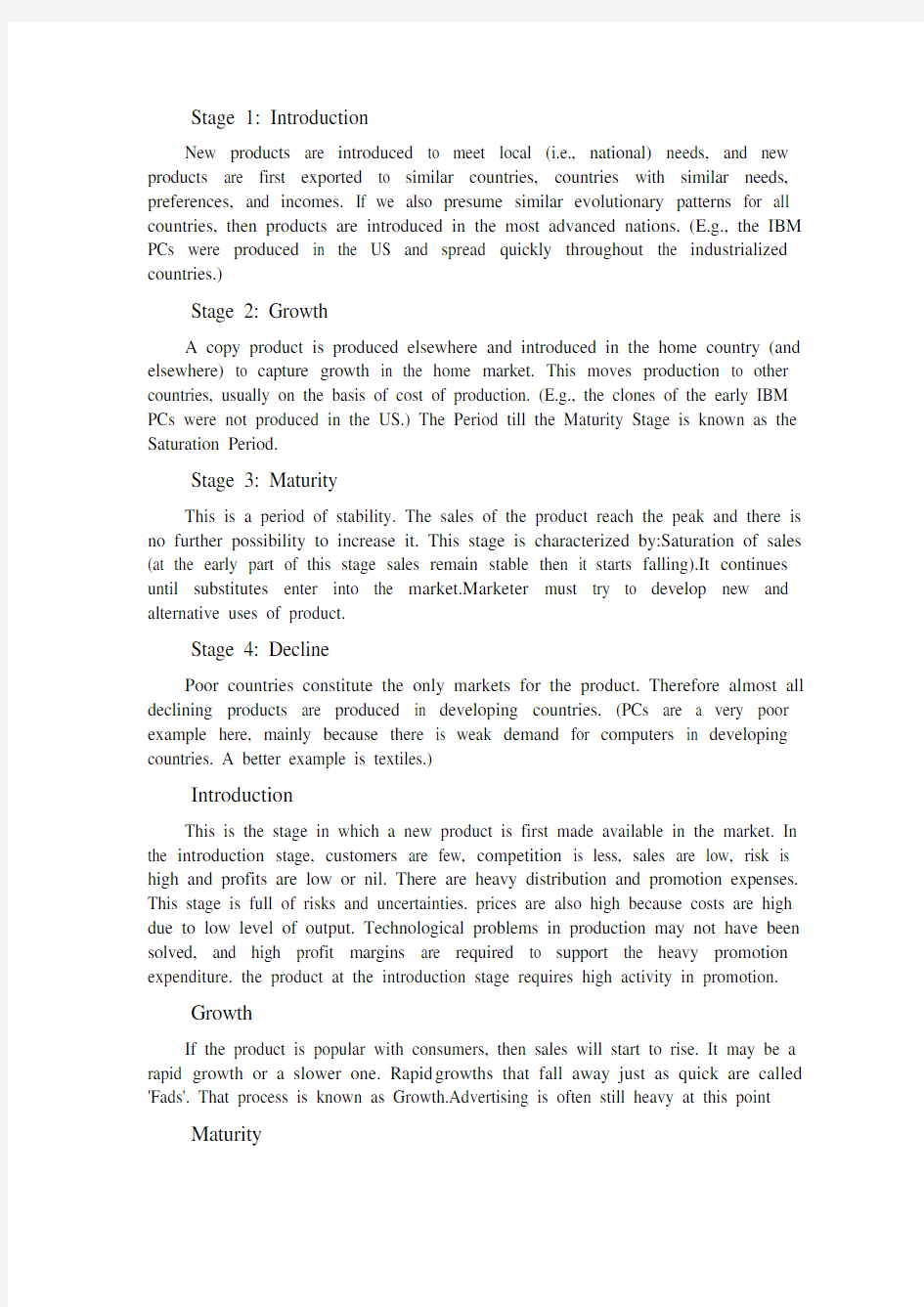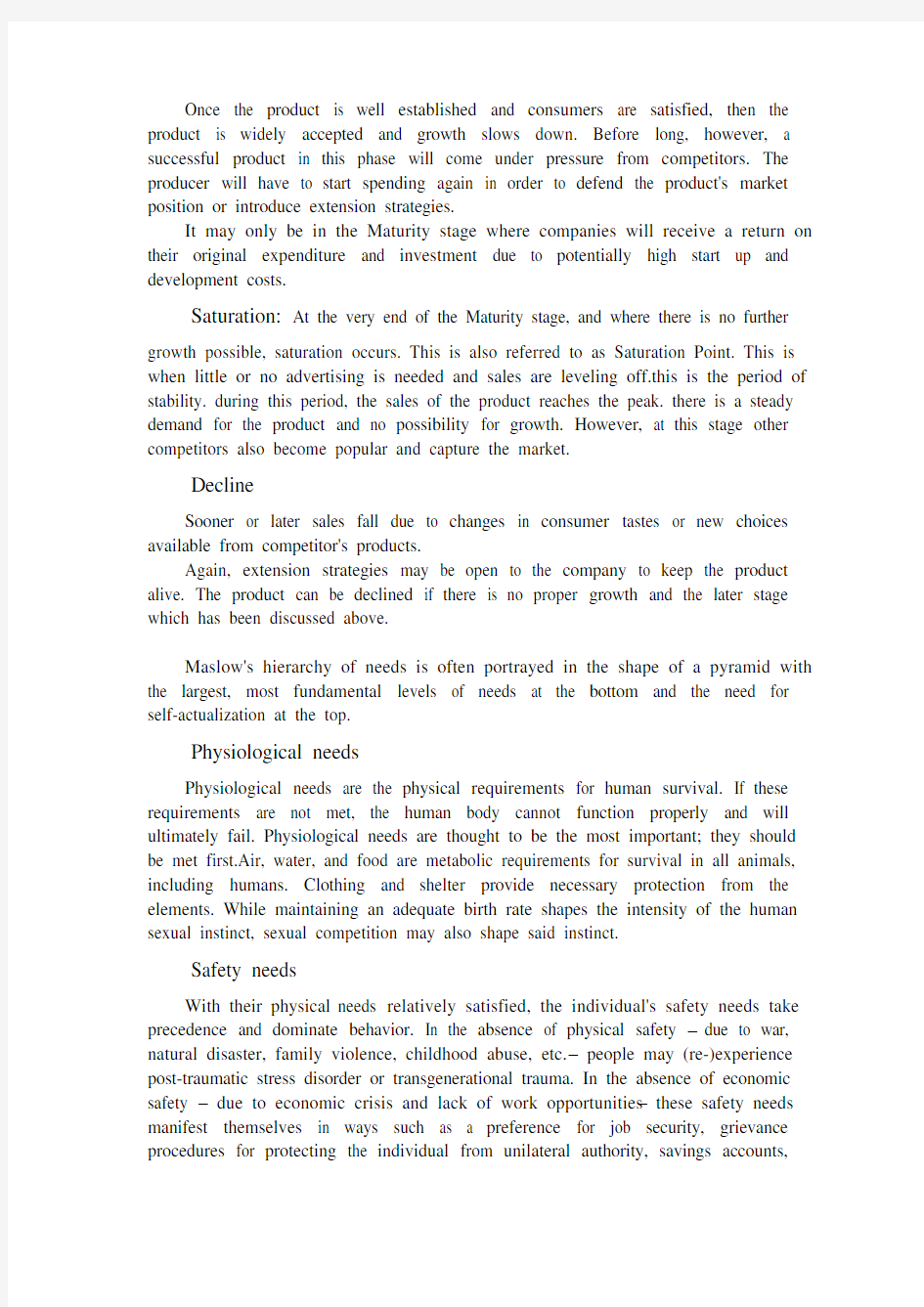市场营销理论(英文总结)


Stage 1: Introduction
New products are introduced to meet local (i.e., national) needs, and new products are first exported to similar countries, countries with similar needs, preferences, and incomes. If we also presume similar evolutionary patterns for all countries, then products are introduced in the most advanced nations. (E.g., the IBM PCs were produced in the US and spread quickly throughout the industrialized countries.)
Stage 2: Growth
A copy product is produced elsewhere and introduced in the home country (and elsewhere) to capture growth in the home market. This moves production to other countries, usually on the basis of cost of production. (E.g., the clones of the early IBM PCs were not produced in the US.) The Period till the Maturity Stage is known as the Saturation Period.
Stage 3: Maturity
This is a period of stability. The sales of the product reach the peak and there is no further possibility to increase it. This stage is characterized by:Saturation of sales (at the early part of this stage sales remain stable then it starts falling).It continues until substitutes enter into the market.Marketer must try to develop new and alternative uses of product.
Stage 4: Decline
Poor countries constitute the only markets for the product. Therefore almost all declining products are produced in developing countries. (PCs are a very poor example here, mainly because there is weak demand for computers in developing countries. A better example is textiles.)
Introduction
This is the stage in which a new product is first made available in the market. In the introduction stage, customers are few, competition is less, sales are low, risk is high and profits are low or nil. There are heavy distribution and promotion expenses. This stage is full of risks and uncertainties. prices are also high because costs are high due to low level of output. Technological problems in production may not have been solved, and high profit margins are required to support the heavy promotion expenditure. the product at the introduction stage requires high activity in promotion.
Growth
If the product is popular with consumers, then sales will start to rise. It may be a rapid growth or a slower one. Rapid growths that fall away just as quick are called 'Fads'. That process is known as Growth.Advertising is often still heavy at this point Maturity
Once the product is well established and consumers are satisfied, then the product is widely accepted and growth slows down. Before long, however, a successful product in this phase will come under pressure from competitors. The producer will have to start spending again in order to defend the product's market position or introduce extension strategies.
It may only be in the Maturity stage where companies will receive a return on their original expenditure and investment due to potentially high start up and development costs.
Saturation: At the very end of the Maturity stage, and where there is no further
growth possible, saturation occurs. This is also referred to as Saturation Point. This is when little or no advertising is needed and sales are leveling off.this is the period of stability. during this period, the sales of the product reaches the peak. there is a steady demand for the product and no possibility for growth. However, at this stage other competitors also become popular and capture the market.
Decline
Sooner or later sales fall due to changes in consumer tastes or new choices available from competitor's products.
Again, extension strategies may be open to the company to keep the product alive. The product can be declined if there is no proper growth and the later stage which has been discussed above.
Maslow's hierarchy of needs is often portrayed in the shape of a pyramid with the largest, most fundamental levels of needs at the bottom and the need for self-actualization at the top.
Physiological needs
Physiological needs are the physical requirements for human survival. If these requirements are not met, the human body cannot function properly and will ultimately fail. Physiological needs are thought to be the most important; they should be met first.Air, water, and food are metabolic requirements for survival in all animals, including humans. Clothing and shelter provide necessary protection from the elements. While maintaining an adequate birth rate shapes the intensity of the human sexual instinct, sexual competition may also shape said instinct.
Safety needs
With their physical needs relatively satisfied, the individual's safety needs take precedence and dominate behavior. In the absence of physical safety –due to war, natural disaster, family violence, childhood abuse, etc. – people may (re-)experience post-traumatic stress disorder or transgenerational trauma. In the absence of economic safety – due to economic crisis and lack of work opportunities – these safety needs manifest themselves in ways such as a preference for job security, grievance procedures for protecting the individual from unilateral authority, savings accounts,
